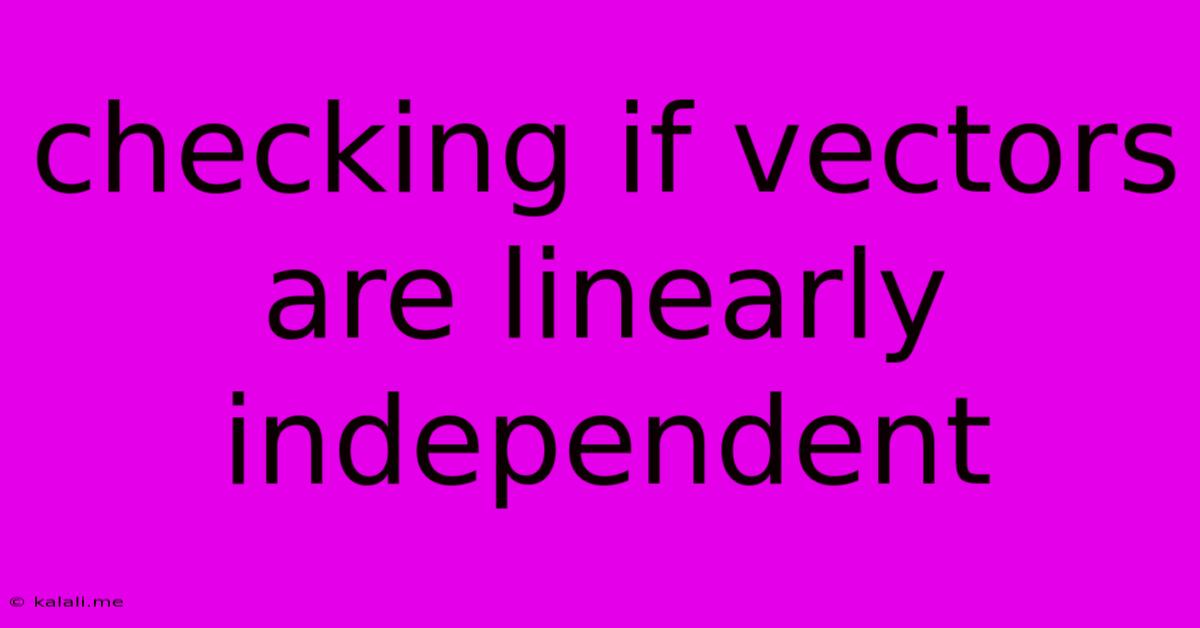Checking If Vectors Are Linearly Independent
Kalali
May 28, 2025 · 3 min read

Table of Contents
Checking if Vectors are Linearly Independent: A Comprehensive Guide
Determining whether a set of vectors is linearly independent is a fundamental concept in linear algebra with crucial applications in various fields, including machine learning, computer graphics, and physics. This article provides a comprehensive guide to understanding and checking linear independence, covering both theoretical concepts and practical methods. Understanding linear independence is key to concepts like basis, dimension, and solving systems of linear equations.
What Does Linear Independence Mean?
A set of vectors is said to be linearly independent if none of the vectors can be written as a linear combination of the others. In simpler terms, this means you can't express one vector as a scalar multiple of another, or as a sum of scalar multiples of the others. Conversely, if you can express one vector as a linear combination of the others, the set is linearly dependent.
For example, consider two vectors in R<sup>2</sup>: v1 = [1, 0] and v2 = [0, 1]. These vectors are linearly independent because neither can be expressed as a scalar multiple of the other. However, if we add the vector v3 = [2, 1], this set becomes linearly dependent because v3 = 2v1 + v2.
Methods for Checking Linear Independence
Several methods exist to determine the linear independence of a set of vectors. The most common methods include:
1. Using the Determinant:
This method is applicable only to square matrices (i.e., the number of vectors equals the dimension of the vector space). Form a matrix where each column represents a vector. If the determinant of this matrix is non-zero, the vectors are linearly independent; otherwise, they are linearly dependent. This method leverages the fact that a non-zero determinant implies the matrix is invertible, which in turn signifies linear independence. Calculating determinants can be computationally expensive for large matrices, however.
2. Row Reduction (Gaussian Elimination):
This is a more general method applicable to both square and non-square matrices. Form a matrix with the vectors as columns. Perform row reduction (Gaussian elimination) to obtain the row echelon form or reduced row echelon form. If the number of non-zero rows (pivots) equals the number of vectors, the vectors are linearly independent. Otherwise, they are linearly dependent. Row reduction is a robust and efficient method for determining linear independence, particularly for larger sets of vectors.
3. Solving a System of Homogeneous Linear Equations:
This method involves setting up a system of homogeneous linear equations where the coefficients are the vector components. If the only solution is the trivial solution (all coefficients equal to zero), the vectors are linearly independent. Any non-trivial solution indicates linear dependence. This method is conceptually similar to row reduction, although the approach differs slightly.
4. Inspection (for simple cases):
For very small sets of vectors, it's sometimes possible to visually determine linear independence by inspection. For instance, if one vector is a scalar multiple of another, they are clearly linearly dependent. This is often a good starting point but is not practical for larger vector sets.
Example: Checking Linear Independence using Row Reduction
Let's consider the following vectors in R<sup>3</sup>:
v1 = [1, 2, 3]
v2 = [4, 5, 6]
v3 = [7, 8, 9]
We form a matrix with these vectors as columns:
[ 1 4 7 ]
[ 2 5 8 ]
[ 3 6 9 ]
Performing row reduction, we find that the matrix reduces to:
[ 1 0 -1 ]
[ 0 1 2 ]
[ 0 0 0 ]
Since there are only two non-zero rows (pivots) and we have three vectors, the vectors are linearly dependent.
Conclusion
Determining linear independence is a critical skill in linear algebra. Understanding the underlying concepts and mastering the various techniques, particularly row reduction, provides a powerful tool for analyzing vector spaces and solving a wide range of problems in mathematics and related fields. Choosing the most efficient method depends on the size and characteristics of the vector set. For larger sets, row reduction generally offers a superior approach in terms of computational efficiency and robustness.
Latest Posts
Latest Posts
-
How Do You Restart A Canon Powershot Camera
May 30, 2025
-
Can I Check Out Of A Hotel Early
May 30, 2025
-
Convert State Plane Coordinates To Latitude And Longitude
May 30, 2025
-
We Are Defently Are Going To Get Along
May 30, 2025
-
3 Way Motion Sensor Switch Wiring Diagram
May 30, 2025
Related Post
Thank you for visiting our website which covers about Checking If Vectors Are Linearly Independent . We hope the information provided has been useful to you. Feel free to contact us if you have any questions or need further assistance. See you next time and don't miss to bookmark.